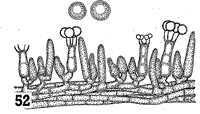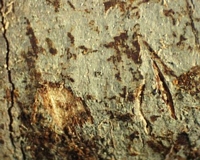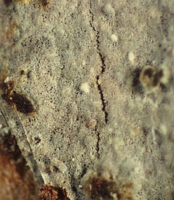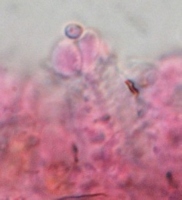|
 Repetobasidium glaucocanum Repetobasidium glaucocanum
SynonymsCorticium glaucocanum
BiostatusPresent in region - Indigenous. Endemic
Images (click to enlarge)
Caption: FIG. 52. Corticium glaucocanum. Showing the ventricose paraphyses, paraphysate
hyphae, and globose spores. | 
Caption: Repetobasidium glaucocanum, BCP 3017
Owner: B.C. Paulus | 
Caption: Repetobasidium glaucocanum, BCP 3017
Owner: B.C. Paulus | 
Caption: Repetobasidium glaucocanum - basidial repetition, BCP 3017
Owner: B.C. Paulus | 
Caption: 7. C. glaucocanum, stages in basidium development, spores and various cystidia. |
Article: Cunningham, G.H. (1963). The Thelephoraceae of Australia and New Zealand. New Zealand Department of Scientific and Industrial Research, Bulletin 145: 359 p. Wellington:.
Description: Hymenophore annual, arachnoid, adherent, effused forming irregular areas to 15 x 3 cm;
hymenial surface dingy white, or bluish-grey, somewhat resembling hoar frost when fresh,
drying to a tenuous barely visible film, even, not creviced; margin thinning out, white,
arachnoid, adherent. Context white, 60-80 µ thick, basal layer of parallel hyphae collapsed
and cemented when old, intermediate layer wanting; generative hyphae 3.5-4 µ diameter,
walls 0.2 µ thick, naked, without clamp connections. Hymenial layer to 25 µ deep, a loose
palisade of basidia, paraphyses, and paraphysate hyphae. Basidia cylindrical with slightly
inflated bases, or narrowly ovate, 16-20 x 6-7 µ, bearing 4 spores; sterigmata arcuate,
slender, to 6 µ long. Paraphyses ovate or pyriform; 9-11 x 5-6 µ. Paraphysate hyphae
cylindrical or tapering slightly to rounded apices, 16-20 x 5-6 µ, abundant. Spores
globose or subglobose, 5-6 µ diameter, walls smooth, hyaline, 0.2 µ thick.
Habitat: HABITAT: Effused on decayed decorticated wood.
Distribution: TYPE LOCALITY: Pohangina Valley, Wellington, New Zealand.
DISTRIBUTION: New Zealand.
Notes: Characters by which the species may be recognised are the small, smooth, globose spores,
ovate or slightly pyriform basidia bearing four spores, cylindrical, abundant paraphysate
hyphae, delicate adherent hymenophore and absence of an intermediate layer. Resembling
hoar frost when fresh, when dried the hymenophore is barely visible, save under a lens.
Article: Stalpers, J.A. (1985). Type studies of the species of Corticium described by G.H. Cunningham. New Zealand Journal of Botany 23(2): 301-310 (http://www.rsnz.org/publish/abstracts.php).
Description: Basidiome when dry reticulate; hymenium not continuous. Hymenial surface whitish. Hyphae
hyaline, thin-walled, 2-3.5 µm wide, with clamps. Cystidia hyaline, thin-walled, apically
containing a resinous drop which stains strongly in phloxine, but not in Melzer's reagent,
smooth or sometimes encrusted with resinous material. Basidia hyaline, thin-walled, often
swollen at the base, 13-18 X 5-8 µm, apically 4-6 µm wide. Some repetobasidia seen. Spores
globose to subglobose, 5-6 X 4.5-6 µm.
Notes: The species belongs to Repetobasidium J. Erikss. and is very close to R. mirificum J. Erikss.,
differing only in the absence of distinctly capitate cystidia.
|